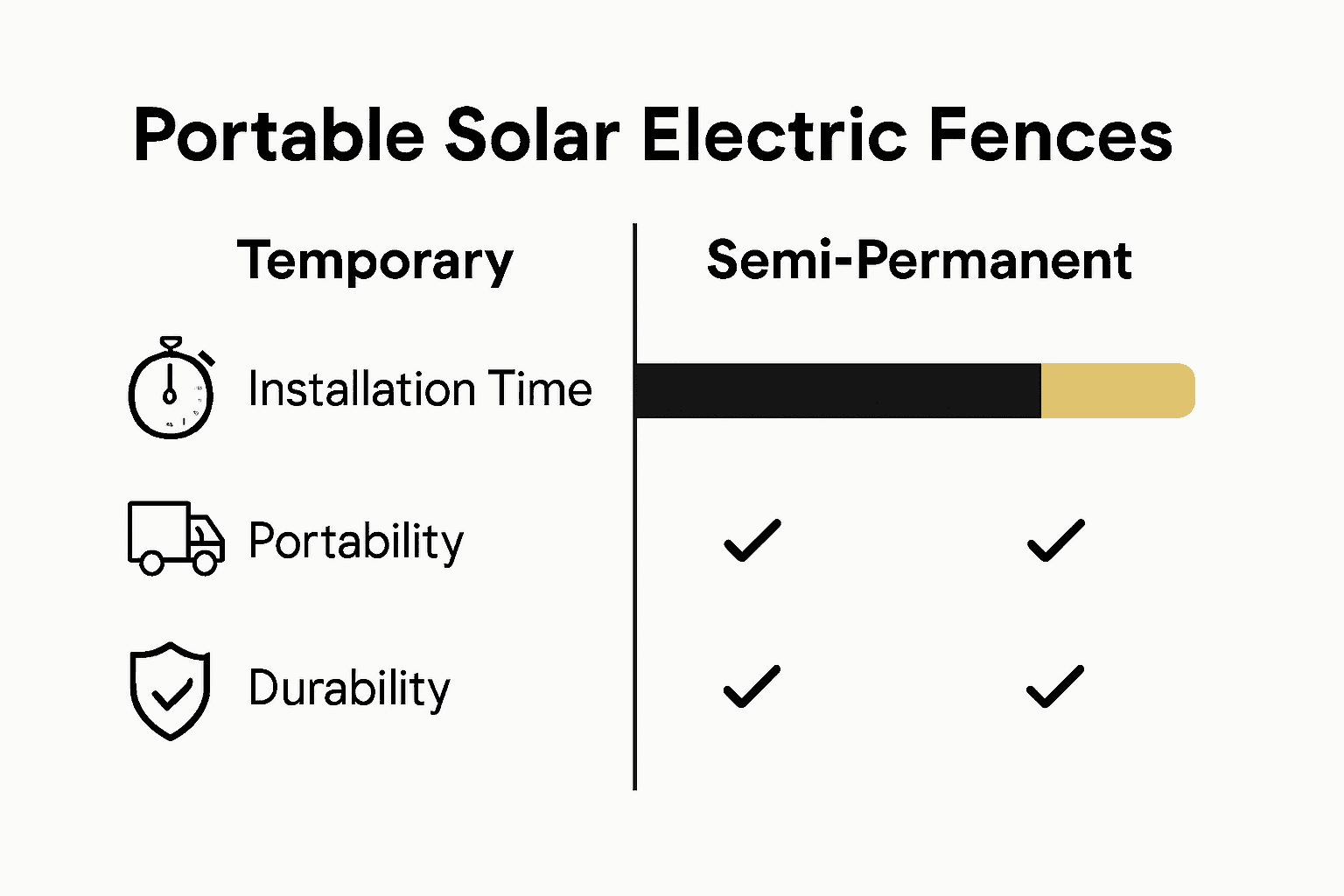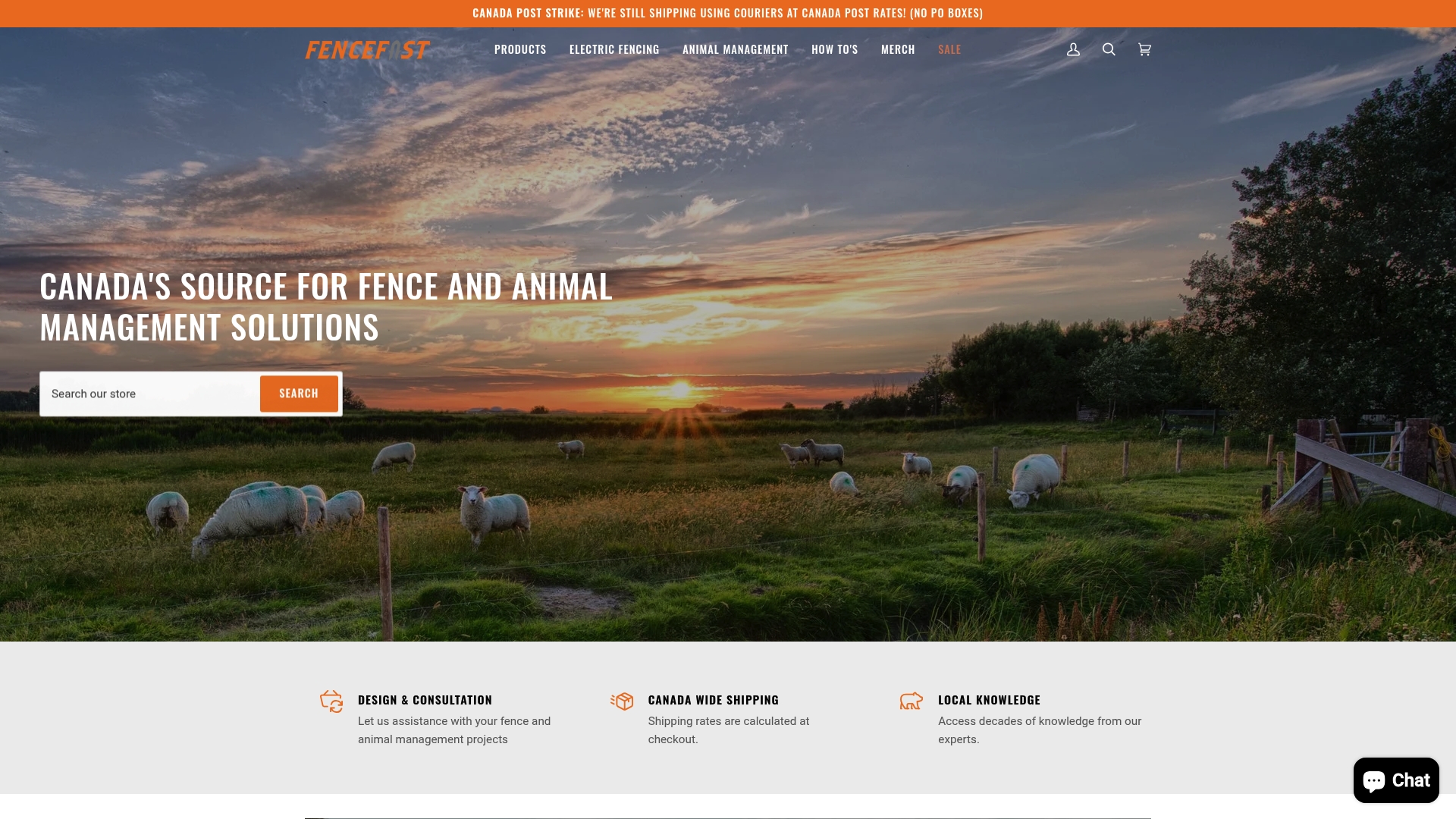Over 60 percent of farmers say flexibility is their top priority when choosing fencing for livestock. Traditional barriers can be costly and hard to move, causing headaches every season. Portable solar electric fences solve these problems by offering easy setup, sustainable power, and adaptable protection in one package. Whether you manage small pastures or large rural properties, understanding these innovative systems can help you find smarter, safer ways to keep your animals secure.
Table of Contents
- Defining Portable Solar Electric Fences
- Major Types And Key Components Explained
- How Solar Electric Fences Operate Safely
- Compliance, Safety, And Canadian Regulations
- Common Mistakes And Cost-Saving Strategies
Key Takeaways
| Point | Details |
|---|---|
| Portable Solar Electric Fences | Offer mobility and solar-powered functionality, ideal for flexible livestock management with no external power source needed. |
| System Configurations | Two main types exist: temporary for short-term use, and semi-permanent for medium-term durability, each suited to different agricultural needs. |
| Safety Mechanisms | Designed to deter animals with a brief shock, safety measures include proper installation, warning signage, and regular inspections to mitigate risks. |
| Cost Management | Effective planning and maintenance strategies, like maintaining a vegetation-free zone and conducting voltage checks, can prevent unnecessary expenses and enhance performance. |
Defining Portable Solar Electric Fences
A portable solar electric fence is a dynamic fencing solution designed for agricultural and rural property management that combines solar power technology with electric fence functionality. Unlike traditional stationary fencing systems, these innovative barriers can be quickly deployed, repositioned, and powered entirely by solar energy, offering unprecedented flexibility for livestock containment and property protection.
According to government agricultural resources BC Government, electric fences operate by delivering a short, high-voltage electrical pulse through conductive wiring when an animal or object completes the electrical circuit. In the case of portable solar electric fences, this core mechanism is enhanced with mobility and renewable energy capabilities.
Key characteristics of portable solar electric fences include:
- Integrated solar panel for independent power generation
- Lightweight and easily transportable design
- Quick setup and breakdown capabilities
- Adaptable to various terrains and livestock management needs
- No requirement for external electrical infrastructure
These versatile fencing systems are particularly valuable for farmers, ranchers, and land managers who need flexible boundary control. Whether you’re managing rotational grazing, protecting crops from wildlife, or creating temporary enclosures, portable electric livestock fence guide offers a comprehensive solution that combines technological innovation with practical agricultural requirements.
Major Types and Key Components Explained
Portable solar electric fences come in two primary configurations: temporary and semi-permanent systems. BC Government emphasizes that regardless of type, all electric fencing requires a specialized fence controller to energize the barrier and ensure effective livestock management.
The core components of a portable solar electric fence system typically include:
- Solar Panel: Generates electrical charge through photovoltaic technology
- Battery Storage Unit: Stores energy for nighttime and low-light operation
- Fence Energizer: Converts stored energy into high-voltage pulses
- Conductive Wiring: Transmits electrical charge throughout the fence
- Grounding System: Ensures proper electrical circuit completion
- Lightweight Support Posts: Enables rapid deployment and repositioning
Temporary systems are designed for short-term use and maximum mobility, ideal for rotational grazing, temporary pasture management, or seasonal crop protection. Semi-permanent systems offer slightly more robust construction with enhanced durability while maintaining portability. Portable Solar Fence Energizer Guide highlights that these systems provide farmers and ranchers unprecedented flexibility in managing livestock boundaries without complex infrastructure investments.
The selection between temporary and semi-permanent portable solar electric fences depends on specific agricultural needs.
Factors like terrain, livestock type, duration of use, and frequency of relocation play crucial roles in determining the most appropriate system. Farmers must consider power requirements, total fence length, and environmental conditions when choosing their ideal portable solar electric fencing solution.

Here’s a summary comparing temporary and semi-permanent portable solar electric fence systems:

| Feature | Temporary System | Semi-Permanent System |
|---|---|---|
| Intended Use | Short-term High mobility |
Medium-term Greater durability |
| Installation Time | Minutes | 30-60 minutes |
| Portability | Very high | Moderate |
| Durability | Light build Lower resistance |
More robust Weather resistant |
| Typical Uses | Rotational grazing Seasonal |
Perimeter fencing Long pasture |
| Initial Cost | Lower | Moderate |
| Reusability | Frequent relocation | Occasional relocation |
How Solar Electric Fences Operate Safely
Solar electric fences operate through a carefully engineered system designed to provide effective containment while prioritizing safety for both livestock and humans. BC Government emphasizes the critical importance of using CSA-approved controllers and ensuring proper installation to maintain safe operational standards.
The fundamental safety mechanism involves delivering a short, high-voltage electrical pulse that creates a psychological barrier rather than causing permanent harm. When an animal or object touches the electrified wire, they complete an electrical circuit that delivers a brief, uncomfortable shock. This pulse typically lasts less than a millisecond, which is designed to startle and deter without causing serious injury. Fence Grounding Safety Guide highlights that a properly grounded system is crucial for predictable and safe electrical discharge.
Key safety considerations for solar electric fences include:
- Clearly marked warning signs to alert people of the electrified boundary
- Minimum recommended wire height to prevent accidental contact
- Regular inspection of fence components and grounding systems
- Ensuring no direct connection to mains-operated electrical equipment
- Maintaining appropriate distance from other electrical infrastructure
For agricultural professionals and property managers, understanding the intricate safety mechanisms is paramount. The goal of a solar electric fence is not to harm, but to create a psychological barrier that effectively manages livestock movement while minimizing risk. By combining solar technology with precision electrical engineering, these systems offer a safe, sustainable solution for boundary management and animal containment.
Compliance, Safety, and Canadian Regulations
Electric fence regulations in Canada represent a comprehensive framework designed to ensure public safety and responsible agricultural practices. Canadian Standards Association mandates strict compliance standards for electric fence energizers, specifically detailing safety requirements under the CAN/CSA-E60335-2-76-05 standard to protect both human and animal welfare.
Provincial regulations provide additional nuanced guidelines for electric fencing implementation. Alberta Government emphasizes the importance of proper fence construction, maintenance, and clear public signage. These regulations typically require property owners to:
- Install visible warning signs at regular intervals
- Maintain fence height and tension standards
- Ensure electrical components meet national safety specifications
- Prevent unauthorized access to electrified boundaries
- Regularly inspect and maintain fence infrastructure
Canadian electric fence regulations prioritize both functional effectiveness and public safety. The legal framework recognizes these systems as critical agricultural tools while implementing stringent protective measures. Property owners must navigate a complex landscape of municipal, provincial, and national guidelines to ensure full compliance.
Beyond regulatory compliance, responsible electric fence management involves understanding local zoning laws, neighboring property rights, and potential liability considerations. Understanding Land Use Guidelines can provide additional context for farmers and rural property owners seeking to implement portable solar electric fencing solutions that meet all necessary legal and safety requirements.
Common Mistakes and Cost-Saving Strategies
Portable solar electric fencing demands careful planning and strategic implementation to maximize effectiveness while minimizing unnecessary expenses. BC Government highlights that many agricultural professionals inadvertently increase their costs through common installation and maintenance errors that could be easily avoided.
Common mistakes that escalate expenses and reduce fence performance include:
- Inadequate ground system installation
- Inconsistent voltage maintenance
- Neglecting regular fence line inspections
- Using incompatible or low-quality components
- Failing to manage vegetation around fence lines
Alberta Government recommends maintaining a vegetation-free buffer zone as a critical cost-saving strategy. This approach prevents electrical failures, reduces maintenance requirements, and extends the overall lifespan of your solar electric fence system. Smart farmers can save significant money by implementing proactive maintenance techniques like:
- Conducting monthly voltage checks
- Replacing damaged components promptly
- Investing in high-quality initial infrastructure
- Utilizing modular fence designs for easy repairs
- Implementing rotational grazing strategies
Ultimately, cost-effective portable solar electric fencing requires a comprehensive approach that balances initial investment with long-term performance. By understanding common pitfalls and adopting strategic maintenance practices, agricultural professionals can develop robust fencing solutions that provide reliable livestock management while keeping operational expenses minimal.
Elevate Your Livestock Management with Portable Solar Electric Fences
Managing livestock boundaries safely and efficiently can be challenging, especially with the need for flexibility, power independence, and compliance with Canadian regulations. If you are looking to simplify this process while ensuring your animals stay secure, portable solar electric fences provide the perfect solution. The key to success lies in using quality components like solar panels, energizers, and grounding systems designed for easy setup and durable performance.

Discover how FenceFast.ca can help you build and maintain professional-grade solar electric fences that match your specific agricultural needs. Whether you want to prevent costly mistakes, enhance fence safety, or implement timely maintenance strategies, our extensive selection and expert advice are ready to support you. Take control of your fencing needs today with reliable products and nationwide support from FenceFast.ca. Start browsing now and secure the ideal portable solar electric fencing system to protect your livestock effectively.
Frequently Asked Questions
What is a portable solar electric fence?
A portable solar electric fence is a dynamic fencing solution designed for agricultural use that combines solar power technology with electric fence functionality, allowing for easy deployment and repositioning without the need for external power sources.
How do portable solar electric fences operate safely?
They operate by delivering a short, high-voltage electrical pulse through conductive wiring, creating a psychological barrier for livestock. Proper installation and grounding are crucial for safety, minimizing the risk of harm to animals and humans.
What are the key components of a portable solar electric fence system?
Key components include a solar panel, battery storage unit, fence energizer, conductive wiring, grounding system, and lightweight support posts, all of which work together to provide efficient power and operation.
What are the differences between temporary and semi-permanent portable solar electric fences?
Temporary fences are designed for short-term use and high mobility, perfect for rotational grazing or seasonal uses, while semi-permanent systems offer more robust construction for medium-term applications, combining durability with portability.
